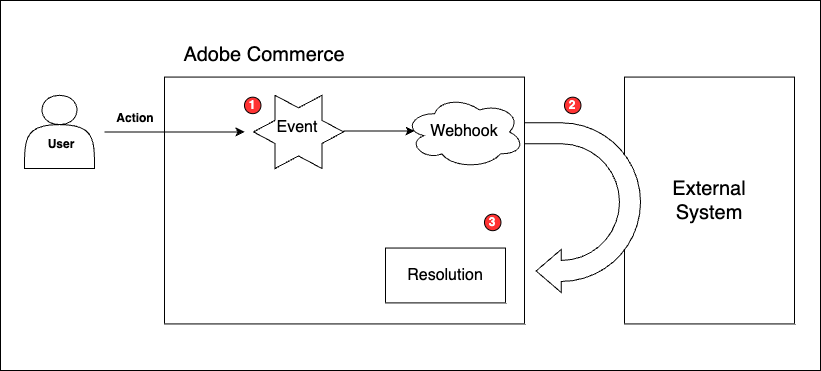Adobe Commerce Webhooks Overview
Webhooks enable developers to configure synchronous logic to execute calls to external systems when an Adobe Commerce event triggers. Synchronous calls are required when Commerce needs to immediately compute or validate something (order totals, taxes, payments) using a 3rd-party endpoint and write the result back into Adobe Commerce.
This process is illustrated in the following diagram.

Webhook execution always starts with an event occurring in Adobe Commerce. This event can occur from many different types of user flows. For example, an event fires when a shopper adds a product to their shopping cart or an administrator creates a quote.
The event triggers a real-time call from Commerce to a URL endpoint, such as an Order Management System. This call contains relevant data, such as the Commerce product SKU and requests information from that external system. As an example, the call could request a product's stock status to make sure it is available to be purchased.
Execution completes by resolving the response from the external system back into the Commerce application. For example, if the external system responds that the product is available, Commerce completes the shopper's action and adds the product to the shopping cart. If the product is not available, the flow is interrupted and an exception is thrown. ("Exception: Product is not in stock"). The shopper cannot add the product to the cart.
Not all situations are ideal for webhooks. You should create a webhook only if synchronous communication with the external server is critical. For many scenarios, asynchronous communication is sufficient, and as a result, Adobe I/O Events for Adobe Commerce might be a better fit.
The resolution of a remote call also determines whether you should implement a webhook. Webhooks currently can be resolved as successful, by throwing an exception, or by modifying the data payload of the event. Use cases can help you understand when to implement webhooks.
Webhook development process
Use these guidelines to develop your own webhooks:
Identify the Adobe Commerce event that triggers a webhook. In Adobe Commerce as a Cloud Service (SaaS), you can browse the available events from the Admin by selecting System > Webhooks > Webhooks List or using the
GET /V1/webhooks/supportedListREST endpoint. In PaaS environments, such as Commerce on Cloud Infrastructure and on-premises, you can accomplish this by running thebin/magento webhooks:list:allcommand to return a list of all supported webhooks methods and thebin/magento webhooks:info <webhook-name>command to return the payload of a specified webhook method.Gather the requirements to make a web call to the external server. This includes the URL, connection information, headers, and the payload the server expects.
Create your webhook. Review the sample use cases for ideas. Extension developers should place this file in the
etcdirectory of their custom module. Merchants who want to implement their own webhooks can define them in the systemapp/etc/webhooks.xmlfile.


